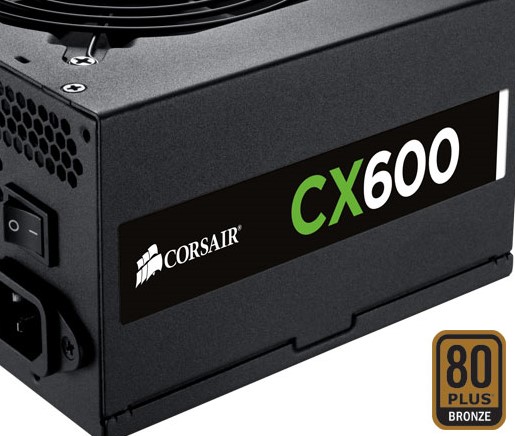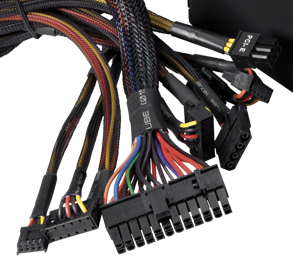How do I buy a PSU that’s right for my PC?
Many custom builders are really not sure what to look in a Power Supply Unit or PSU and end up just buying one without too much thought.
The PSU coverts AC from the mains to DC voltage that supplies each computer component with the power they need to get the job done. A common mistake is buying a PSU with not enough or too much power because it’s difficult to try to work out how much you’ll need.
Here’s a quick rundown of how to estimate the power needed as well the other essential features you should be aware of when selecting a power supply for your build.
How much power do you need?
At this stage in the build process you should have picked your processor, motherboard, memory, graphics card and storage drives. Now you need to work out how much power (in Watts) these components need to run properly. This is where some custom PC builders start scratching their heads.
Luckily it’s so much easier than it used to be because there are many sites that include a calculator which is able to estimate the power rating needed for your PSU. All you have to do is tell the calculator which parts will be in your custom build and the tool will work the wattage out for you.
I’ve found the CoolerMaster one quite comprehensive and easy to use.
I recommend going a bit higher than the estimated rating calculation to cover any upgrades in the future. Don’t be afraid of buying extra power, your pc won’t be guzzling all the extra power. The system components are intelligent enough to consume only what they need. With a 500W PSU the components will only use 250W if that’s what they need under load.
Apart from the power rating also look for how the power is delivered to your components. Peak power is the maximum power that can be used but continuous power delivers the right amount of power without any fluctuations all the time the computer is on.
This constant level of power is more important than the maximum or peak power that the PSU is capable of supplying especially for high power computers like gaming rigs.
80 Plus – an efficient PSU is a cool and quiet PSU

All electrical components produce heat and PSUs are no exceptions. The more efficient the power supply is the less heat it produces and the less power it uses, but why worry about heat?
Heat causes components to fail prematurely and the fans used to remove heat can be noisy. Computer power supplies have an 80 Plus rating system to indicate how efficient they are ranging from White, Bronze, Silver, Gold, Platinum and Titanium.
They are 80% efficient in producing power and also have better components inside which means the power supply should last. The higher up the scale the more efficient but the higher the price.
Normal builds should be ok with White and Bronze ratings but if you’ve got a bit extra in your budget try to go for Sliver or higher. The PSU is the power house that drives your PC and is one of the main components that can be reused so it’s well worth getting an efficient PSU.
Modular vs Non Modular
Modular power supplies are a good idea, they separate the cables from the unit so that you only need to plug in the cables that you need. Non Modular or normal PSU’s have all the cables and connectors permanently attached to the unit.
For example if you only need one SATA connection from the PSU, all the other cables can clog up the case and disrupt air flow. For a modular PSU you simply plug only the SATA cable in and save the rest for any future upgrades.
It would be a no brainer to recommend modular PSU’s were it not for one small problem, the price. Unfortunately, modular PSU’s cost about 50% more for a similar non-modular PSU so for most budgets, modular PSU’s are not value for money.
Modular PSU’s are one of those components that are not a must have but are a would be nice to have.
A good alternative is a hybrid PSU that has some permanently attached cables but not all. These power supplies are a better value for money option if you really have your heart set on a modular PSU.
To single rail or to multi rail? You will see some PSU’s labelled as single rail and some as multi rail, what’s the difference?
The voltage from the PSU is regulated by the motherboard which monitors the amount of current going to the different components. **When too much current is supplied the computer turns itself off rather than frying your components. Single rail PSU’S offer less protection against too much current but that’s fine for lower rated PSU’s (under 900W) because they do not supply that much current.
This circuit protection is more important for higher rated PSU’s (over about 900W) which supply more current. If your build uses a PSU with a rating of over 900W you should consider a multi rail PSU to prevent shorting your motherboard, graphics card or other components especially if you’re overclocking.
Don’t forget about the Connectors

Check you have enough connectors and then some. All your components inside your new computer need power so make sure you check to see if you have enough power connectors on the PSU.
The main ones are the mainboard 20+4 pin, the 4+2 pin motherboard power, the expansion card 4+2 or 6+2 pins, SATA and the legacy Molex and floppy connectors.
Pick a size (Form factor)
PSU’s come in different sizes and you will need to make sure that it will fit into your chosen case.
The standard size is the ATX form factor (150mm x 85mm x 140mm) but it’s best to check the dimensions of the PSU in the description and match the size of case you’ll be buying.
PSU Brand and warranty matter
PSU’s should be built to last, after all the other components are relying on it to provide consistent and reliable power during operation. There are cheap PSU’s on the market which are fine for low end builds but for most builds you should look for manufacturers that back their products with at least 3 year warranties. I also recommend known brands because of the quality capacitors and heat sinks under the hood.
